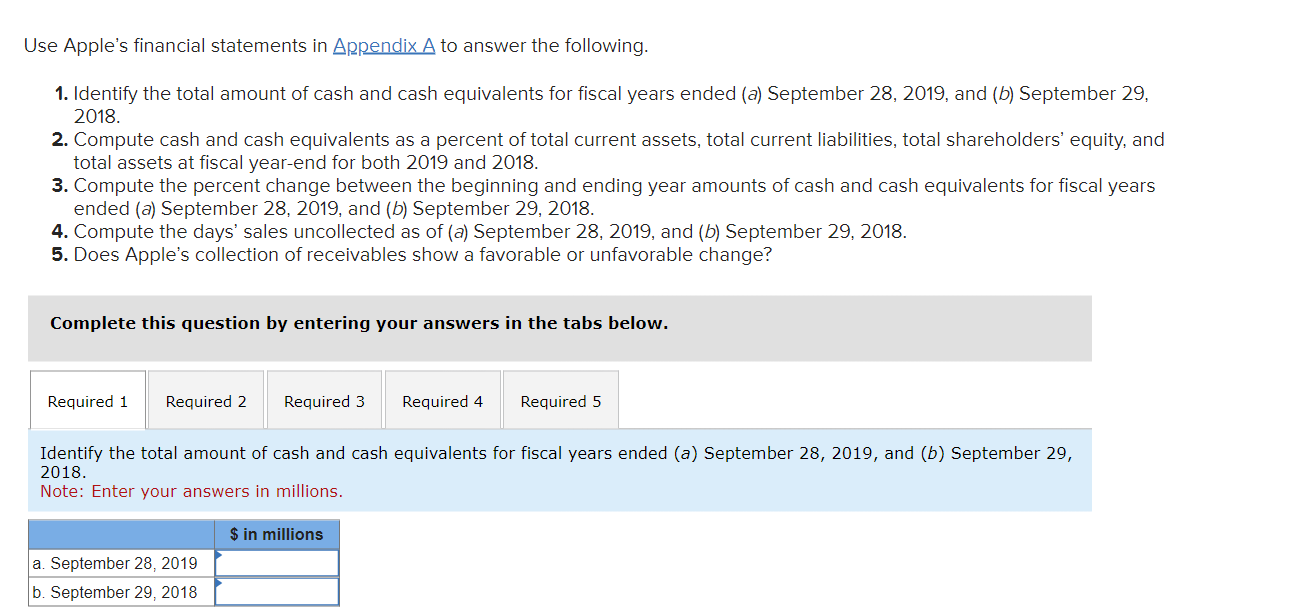

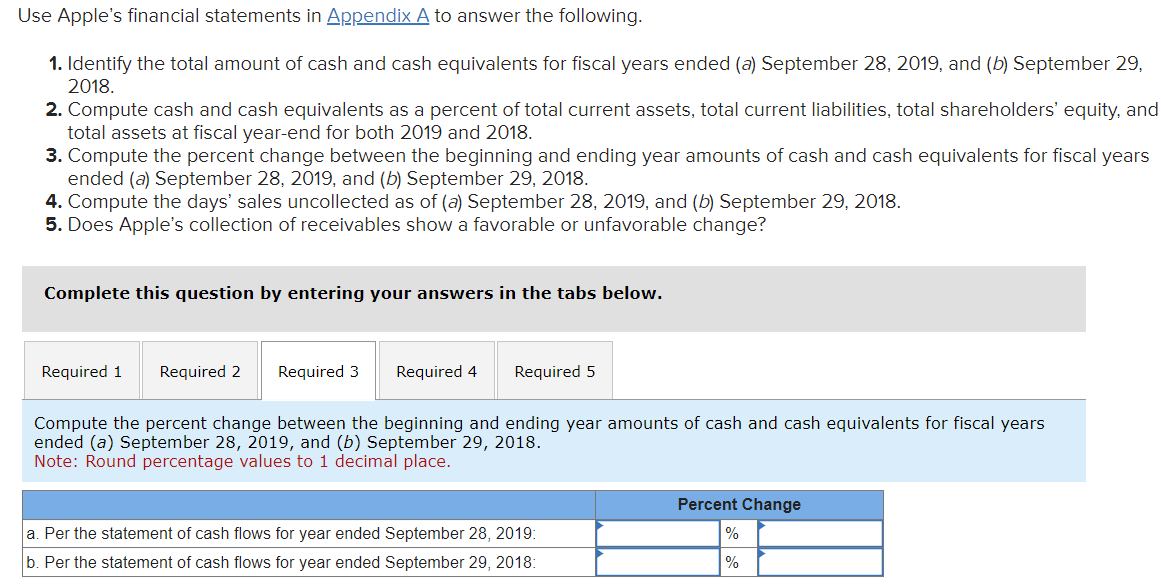
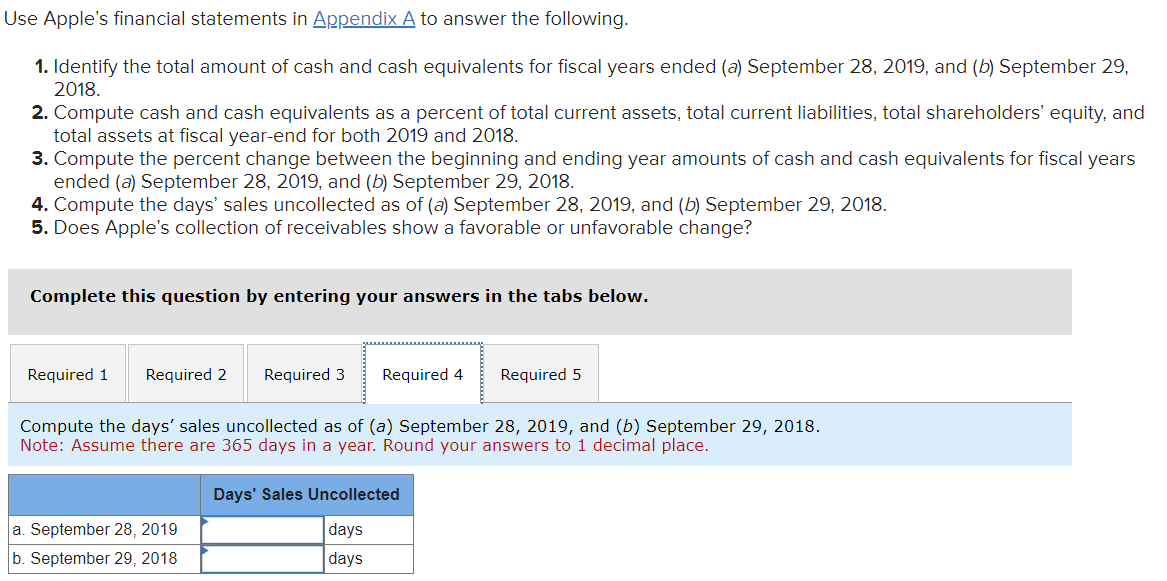
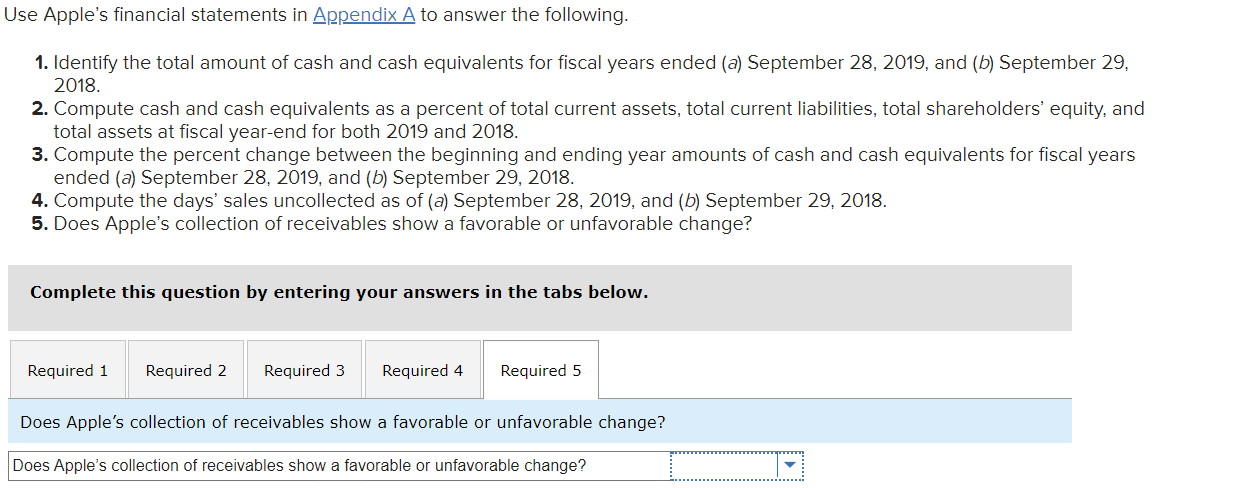
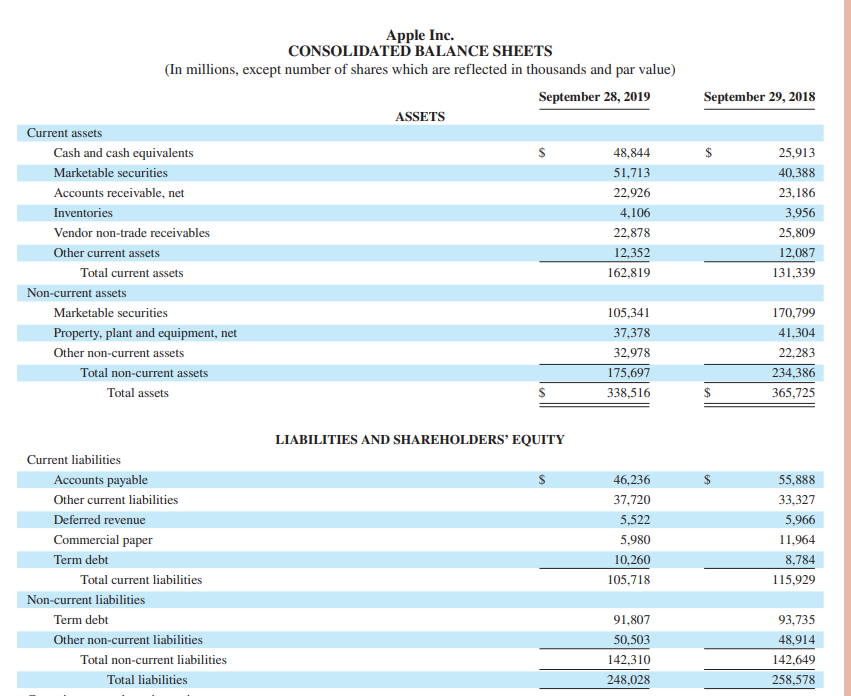
Use Apples financial statements in Appendix A to answer the following.
- Identify the total amount of cash and cash equivalents for fiscal years ended (a) September 28, 2019, and (b) September 29, 2018.
- Compute cash and cash equivalents as a percent of total current assets, total current liabilities, total shareholders equity, and total assets at fiscal year-end for both 2019 and 2018.
- Compute the percent change between the beginning and ending year amounts of cash and cash equivalents for fiscal years ended (a) September 28, 2019, and (b) September 29, 2018.
- Compute the days sales uncollected as of (a) September 28, 2019, and (b) September 29, 2018.
- Does Apples collection of receivables show a favorable or unfavorable change?
Use Apple's financial statements in Appendix A to answer the following. 1. Identify the total amount of cash and cash equivalents for fiscal years ended (a) September 28, 2019, and (b) September 29 , 2018. 2. Compute cash and cash equivalents as a percent of total current assets, total current liabilities, total shareholders' equity, and total assets at fiscal year-end for both 2019 and 2018. 3. Compute the percent change between the beginning and ending year amounts of cash and cash equivalents for fiscal years ended (a) September 28, 2019, and (b) September 29, 2018. 4. Compute the days' sales uncollected as of (a) September 28, 2019, and (b) September 29, 2018. 5. Does Apple's collection of receivables show a favorable or unfavorable change? Complete this question by entering your answers in the tabs below. Identify the total amount of cash and cash equivalents for fiscal years ended (a) September 28, 2019, and (b) September 29, 2018. Note: Enter your answers in millions. 1. Identity the total amount of cash and cash equivalents tor tiscal years ended (a) September 28,2019 , and (b) September 29 , 2018. 2. Compute cash and cash equivalents as a percent of total current assets, total current liabilities, total shareholders' equity, and total assets at fiscal year-end for both 2019 and 2018. 3. Compute the percent change between the beginning and ending year amounts of cash and cash equivalents for fiscal years ended (a) September 28, 2019, and (b) September 29, 2018. 4. Compute the days' sales uncollected as of (a) September 28, 2019, and (b) September 29, 2018. 5. Does Apple's collection of receivables show a favorable or unfavorable change? Complete this question by entering your answers in the tabs below. Compute cash and cash equivalents as a percent of total current assets, total current liabilities, total shareholders' equity, and total assets at fiscal year-end for both 2019 and 2018. Note: Round percentage values to 1 decimal place. Use Apple's financial statements in Appendix A to answer the following. 1. Identify the total amount of cash and cash equivalents for fiscal years ended (a) September 28, 2019, and (b) September 29, 2018. 2. Compute cash and cash equivalents as a percent of total current assets, total current liabilities, total shareholders' equity, an total assets at fiscal year-end for both 2019 and 2018. 3. Compute the percent change between the beginning and ending year amounts of cash and cash equivalents for fiscal years ended (a) September 28, 2019, and (b) September 29, 2018. 4. Compute the days' sales uncollected as of (a) September 28, 2019, and (b) September 29, 2018. 5. Does Apple's collection of receivables show a favorable or unfavorable change? Complete this question by entering your answers in the tabs below. Compute the percent change between the beginning and ending year amounts of cash and cash equivalents for fiscal years ended (a) September 28, 2019, and (b) September 29, 2018. Note: Round percentage values to 1 decimal place. Use Apple's financial statements in Appendix A to answer the following. 1. Identify the total amount of cash and cash equivalents for fiscal years ended (a) September 28, 2019, and (b) September 29, 2018. 2. Compute cash and cash equivalents as a percent of total current assets, total current liabilities, total shareholders' equity, and total assets at fiscal year-end for both 2019 and 2018. 3. Compute the percent change between the beginning and ending year amounts of cash and cash equivalents for fiscal years ended (a) September 28, 2019, and (b) September 29, 2018. 4. Compute the days' sales uncollected as of (a) September 28, 2019, and (b) September 29, 2018. 5. Does Apple's collection of receivables show a favorable or unfavorable change? Complete this question by entering your answers in the tabs below. Compute the days' sales uncollected as of (a) September 28, 2019, and (b) September 29, 2018. Note: Assume there are 365 days in a year. Round your answers to 1 decimal place. Use Apple's financial statements in Appendix A to answer the following. 1. Identify the total amount of cash and cash equivalents for fiscal years ended (a) September 28, 2019, and (b) September 29, 2018. 2. Compute cash and cash equivalents as a percent of total current assets, total current liabilities, total shareholders' equity, and total assets at fiscal year-end for both 2019 and 2018. 3. Compute the percent change between the beginning and ending year amounts of cash and cash equivalents for fiscal years ended (a) September 28, 2019, and (b) September 29, 2018. 4. Compute the days' sales uncollected as of (a) September 28, 2019, and (b) September 29, 2018. 5. Does Apple's collection of receivables show a favorable or unfavorable change? Complete this question by entering your answers in the tabs below. Does Apple's collection of receivables show a favorable or unfavorable change? Apple Inc. CONSOLIDATED BALANCE SHEETS (In millions, except number of shares which are reflected in thousands and par value)












